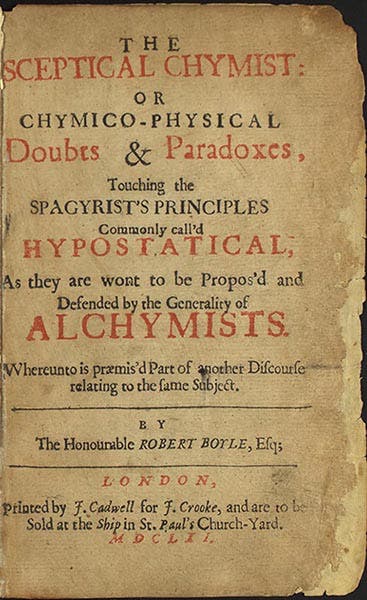Scientist of the Day - Robert Boyle
Robert Boyle, an Irish natural philosopher who lived most of his life in England, was born Jan. 25, 1627. He adopted the "corpuscular philosophy,” meaning he thought that sensible matter is comprised of much smaller particles; he believed that natural philosophy should be founded almost exclusively on experiment; he was one of the founders of the Royal Society of London (1660 and 1662), becoming one it its most distinguished members; and he believed devoutly that the purpose of science, or indeed of any inquiry, was to glorify and demonstrate the attributes of God. In the late 1650s, he and his assistant Robert Hooke built an air pump (we would call it a vacuum pump) with which to investigate the properties of a space from which the air has been evacuated, in the process discovering his best known eponym, Boyle's law, which relates volume to pressure. Boyle's investigations into the nature of the vacuum were reported in The Spring of the Air (1660) and a greatly enlarged second edition (1662) that contains the first statement of his pressure-volume law. We discussed and illustrated Boyle’s work with the air pump in our first post on Boyle five years ago.
But for many people, especially anyone who has taken a high-school chemistry course, Boyle is better known for a book provocatively titled The Sceptical Chymist (1661). In fact, the provocation continues as the title continues: Or, Chymico-Physical Doubts & Paradoxes, Touching the Spagyrist’s Principles, Commonly call’d Hypostatical, as they are wont to be Propos’d and Defended by the Generality of Alchymists. In the first edition (which we do not have in our collections) the words Sceptical, Chymist, Doubts, Paradoxes, Hypostatical, and Alchymists are in a bright red font. Spagyrists, incidentally, were chemical physicians, followers of the controversial 16th-century figure, Paracelsus. The title page we show here was taken by Wikimedia commons from the Gutenburg Project; it is not clear who owns this copy.
Until 1980 or so, Boyle’s book was popularly known and extolled for proposing the modern idea of the element and for demolishing alchemy as a science. Neither of these is even close to true. Recent historians of alchemy and chemistry have shown that although Boyle used the word element, he did not believe that any matter was elemental – certainly not the many things we call elements, such as gold, lead, and iron. And Boyle did not attack alchemy as a science, nor would he have, since he was one of its foremost practitioners. Rather, he attacked the building of systems, such as Aristotle’s four elements, or the three principles (sulphur, mercury, salt) of the Paracelsians. Boyle was opposed to “sooty empirics,” those who worked in the laboratory without direction or thought and did not know how to design experiments. But experimental alchemy guided by natural philosophy was for Boyle the highest of sciences, and one he pursued until he could pursue no more.
There is another point made in the Sceptical Chymist that deserves more notice than it gets. The reason why Boyle preferred alchemy over all other sciences is that it had always been, from its earliest days, and even when abused, the quintessential experimental science. Aristotle formulated entire sciences, such as physics, without once entering a lab. You could propose on a priori principles how a body might behave if thrown up in the air or struck by another body. But you could not do that with the science of matter. Alchemy had to be a practice. You could propose hypotheses and likely outcomes, but the only way to test those was by experiment. Alchemy was, for Boyle, the science that best exemplifies the importance of experiment in understanding Nature.
The first edition of The Sceptical Chymist is one of the great rarities of the history of science, much scarcer than most other milestone books, such as Galileo’s Sidereus nuncius or Copernicus’ De revolutionibus. The second edition of 1680 is important in its own right for having an added treatise, and we are pleased to have it. In fact, we have two copies of the 1680 edition (third image). But it is very unlikely that we will ever be able to show visitors a copy of Boyle’s book with the word Alchymists emblazoned in blood-red ink on the title page.
In our first post on Boyle, we included the engraved portrait from the 1772 edition of Boyle’s works that we have in our collections. For this occasion, we show the original of nearly all of the Boyle portraits that survive (including our engraving), the oil painting by Johann Kerseboom of 1689 that is the property of the Royal Society of London (first image).
Dr. William B. Ashworth, Jr., Consultant for the History of Science, Linda Hall Library and Associate Professor emeritus, Department of History, University of Missouri-Kansas City. Comments or corrections are welcome; please direct to ashworthw@umkc.edu.








